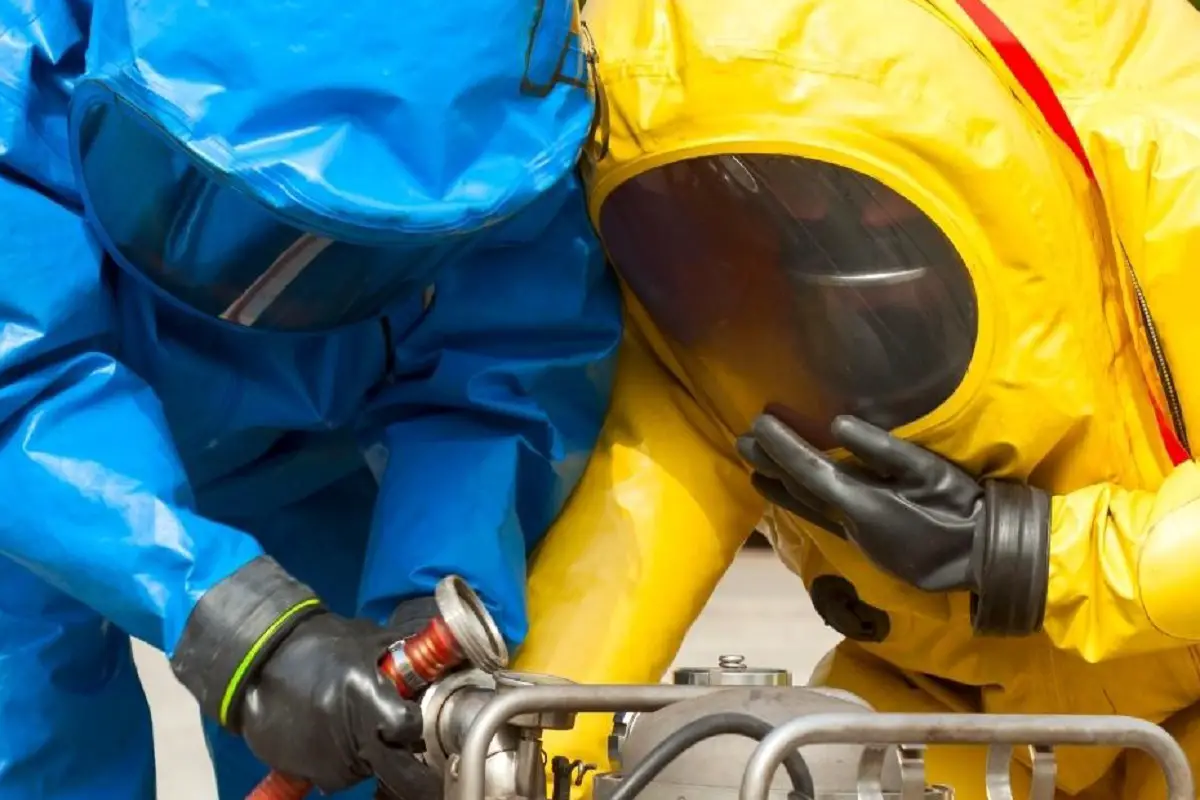Hazmat suits come in a variety of colors and color combinations. Which one you use may depend on a number of factors. Find out more in this post.
As an Amazon Associate, SelectSafety earns commissions from qualifying purchases made through links in this post.
Hazmat Suit Colors
Typically hazmat suits are available in the following colors:
- Blue
- Red
- Orange
- Yellow
- White
- Silver
- Black
Certain jobs require specific hazmat suit colors. For instance, firefighters wear different suits with medical personnel or hazardous material technicians. This avoids confusion in emergency environments when the skills and protection of safety personnel are paramount. Some colors are more rarely seen in hazmat suits and have not become popular in certain fields.
Manufacturers of hazmat suits may also provide hazmat suit colors that represent different levels of protection offered and materials used in their construction.
Why Are Hazmat Suits Yellow?
Yellow is a common color for hazmat suits with different protection levels because it can be spotted quite easily. As such, yellow hazmat suits can be spotted quickly and easily to keep people safe. Yellow shows ups well during the day and in low lighting. Yellow is often worn by those working with hazardous materials.
Yellow is a color most commonly associated with “caution”, so yellow hazmat suits are good for visibility and not being ignored by anyone who may enter an unsafe area.
Here are three excellent yellow hazmat suits to check out if you’re looking for chemical protection:
DuPont Tychem 2000 Hazmat Suit Disposable Coverall – Yellow
DuPont Tychem QC125 Hazmat Suit – Yellow
AMZ Medical Supply Disposable Hazmat Suit (Pack of 5) – Yellow
Why Are Hazmat Suits White?
Most hazmat suits, especially single-use versions are white in color. Why? There is a very good reason for hazmat suits to be white and not black or pink or red: white tends to keep workers cooler. Also, medical fields tend to prefer white hazmat suits over other colors. White hazmat suits are also commonly worn by laboratory workers as well.
Here are several white hazmat suits that provide solid protection:
YIBER Disposable Coverall Hazmat Suit / Heavy Duty Painters Coveralls – White
Medtecs Disposable Coverall Hazmat Suit for Biohazards & Chemicals – White
Raygard 30203 Microporous Disposable Coveralls Breathable Hazmat Suit – White
Why Are Hazmat Suits Red?
Level A hazmat suits are often red to represent the high level of protection they offer. Red hazmat suits are used in an environment where the wearer is exposed to extremely hazardous chemicals or biological hazards.
The color red represents danger and highly infectious materials. When someone sees a hazmat suit, they will know that it’s required for dangerous materials. Manufacturers dye hazmat suits red because of their high visibility.
Why Are Hazmat Suits Blue?
Blue hazmat suits are available for hazmat technicians to use when they are handling hazardous materials. The blue hazmat suits provide protection from chemicals that could be ingested or inhaled by the hazmat technician during a response operation.

Bio-research labs or areas that have hazardous biological chemicals tend to have blue hazmat suits in the facility. Blue is a color associated with medical and biological dangers.
Blue coveralls are also used in hospitals to protect against biological waste and splashes. Here are a few blue hazmat suits appropriate for this purpose:
AMZ Medical Supply Disposable Coverall – Blue
ABC Disposable Coverall Polypropylene Hazmat Suit – Blue
ZMDREAM Disposable SMS Protective Hazmat Suit – Blue
Why Are hazmat Suits Green?
Green hazmat suits can be purchased and worn by anyone. The military often uses hazmat suits that are green. Green is an “official” and plain color and tends to represent government, police, or military activity.
A highly protective hazmat suit in green is the MIRA Safety Disposable Coverall Hazmat Suit.
Why Are Hazmat Suits Orange?
Orange hazmat suits are fairly common in the hazmat world due to safety reasons. Orange is known as a safety color because it’s highly visible, quickly noticed, and easily interpreted. This visibility is important when working with hazmat chemicals since hazmat workers must avoid contact with them at all costs.
Orange hazmat suits are also often used in general construction, roadside cleanup, and painting projects.
Why Are Hazmat Suits Silver?
Hazmat suits are silver for a very specific reason: they are reflective and help to keep the suit from getting too hot from exposure to intense heat and solar rays. Silver hazmat suits are often used by geologists for working near active volcanoes.
Fire proximity hazmat suits are silver and made of aluminized materials that reflect the heat of fires. This helps to keep the firemen cool while working in these intense situations.
Why Are Hazmat Suits Black?
Black hazmat suits are not very common. One reason is that black gets too hot in the sun and in enclosed facilities without proper ventilation. A black hazmat suit will need to be worn with a breathing apparatus and even a cooling vest underneath to help keep the worker from overheating. However, chemical-resistant PVC-coated work gloves and boots are often black.
UP NEXT: Are HAZMAT Suits Radiation Proof?
To Close
Regardless of which hazmat suit you choose to wear, the most important factor is how it keeps you safe. If the suit shows any damage, immediately remove it and replace it with a new one.
Looking for a new HAZMAT suit? Check out our our Hazmat Suits Buying Guide for some good tips on buying your next one.


